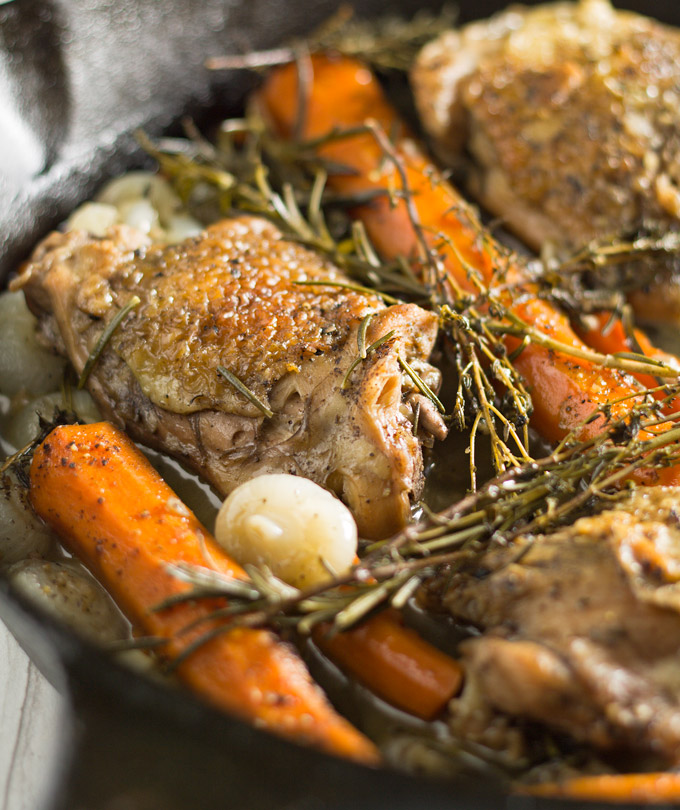Food & Wine Pairing: Pinot Noir
/This post contains affiliate links. We will earn a small commission from any purchases made via the links provided. Your support is appreciated.
For whatever reason, lately everyone around me seems to be hot on Pinot Noir. It’s no secret that Pinot Noir is my least favorite wine, but I’ve been trying to branch out and at least find something redeemable about this popular red wine. I’ve been trying for several years to jump on the Pinot Noir bandwagon, but it seems as though every Pinot I try falls short of my expectations. However, since the purpose of this blog is to learn about wine, I figured there was no better time than now than to learn how to properly pair Pinot Noir.
Roasted Thyme & Carrots Farro via Luci's Morsels
I began this project the same place anyone else might: my dear friend Google. After finding plenty of vague answers, I began asking wine makers and wine directors of restaurants I frequented their tips and tricks. For the most part, when they spoke about specific pairings, they mentioned specific bottles—because the average wine drinker isn’t comfortable spending $90 on a bottle of wine, I have chosen affordable wines.
When most of us think about red wine, we think of the big, full-bodied, heavy tannin wines such as Merlot or Cabernet Sauvignon; acidity is the foundation of Pinot Noir.
The Back Story Of Pinot Noir
Rabbit and Vegetable Bake via Peas & Peonies
Like so many other wines, Pinot Noir originates from Burgundy, France. It’s a light- to medium-bodied wine, with thin pigmentation (meaning you can typically see through it), very low tannins and medium to high acidity. Like Chardonnay, there can be different styles of Pinot Noir; elegant and smooth or a punch to the face.
Pinot Noir has a fantastic ability to showcase the terrior in which it was grown, which simply means, with enough care and drinking, you’ll literally be able to taste the ground in which it was grown in. It’s because of this quality that Pinot Noir is one of the most versatile wines when it comes to pairing.
It should come as no surprise that Pinot Noirs from Burgundy can be among the most expensive wines in the world, and for good reason. Rumor has it, a few vineyards in Coastal Central California (Monterey County's Arroyo Seco and Santa Lucia Highlands appellations) share the same limestone-rich soil and those wines are far cheaper, while the same quality.
The Pairing Basics
Apricot Glazed Cornish Hens via Say Grace
Pinot Noir can be broken into four basic styles: light and fruity; smooth and supple; earthy and spicy; and finally, big and bold. Again, let's think back to the concept of mirroring—lighter dishes with lighter styles of wine and heavier dishes with heavier wines. When grown in cooler climates such as France, Italy and parts of the Santa Lucia Highlands in California will provide Pinots that are earthy with some acidic rusticness to them, while those grown in warmer parts of the world are going to be higher in alcohol, fruitier with vanilla flavors from being aged in oak.
Generally speaking, salmon and other fatty fish and roasted chicken will pair nicely with light and fruity Pinot Noir while game birds such as duck and quail need the more robust Pinot Noirs from cooler climates. One of the few times I've found myself enjoying a glass of Pinot Noir was with a bowl of beef bourguignon. According to industry folks, bring out the best qualities in Pinot Noir with dishes that have autumn fruits, aromatic spices and braised or otherwise slow-cooked meats. To bring out the earthiness of the wine, pair it with mushrooms, truffles or mustard-based sauces. Smoking your meat doesn’t hurt, either.
Lamb Chops with Béarnaise Sauce via Mon Petit Four
A few rules of thumb: a mortal mistake when pairing a Pinot Noir is with an acidic dish. It destroys the wine's fruity undertones. No spicy Mexican or hot Sichuan. No smoked or glazed BBQ, no bitter foods or overly elaborate dishes. According to the results of my homework, Pinot Noir is incredibly versatile when it comes to food. Shell fish will typically work, just as long as they aren't smothered by a creamy sauce.
Rosemary Chicken with Sautéed Onion Wine Sauce via Bam's Kitchen
Tea Braised Chicken Thighs via Honey and Birch
Pork Medallions with Tarragon Cream Sauce via Platings and Pairings
Veal Cotolette Milanese Burger via Chew Town
Herb Crusted Pork Tenderloin via Zagleft
What's your go-to Pinot Noir pairing?
For more pairing ideas, check out our Pinot Noir Pinterest board.





















